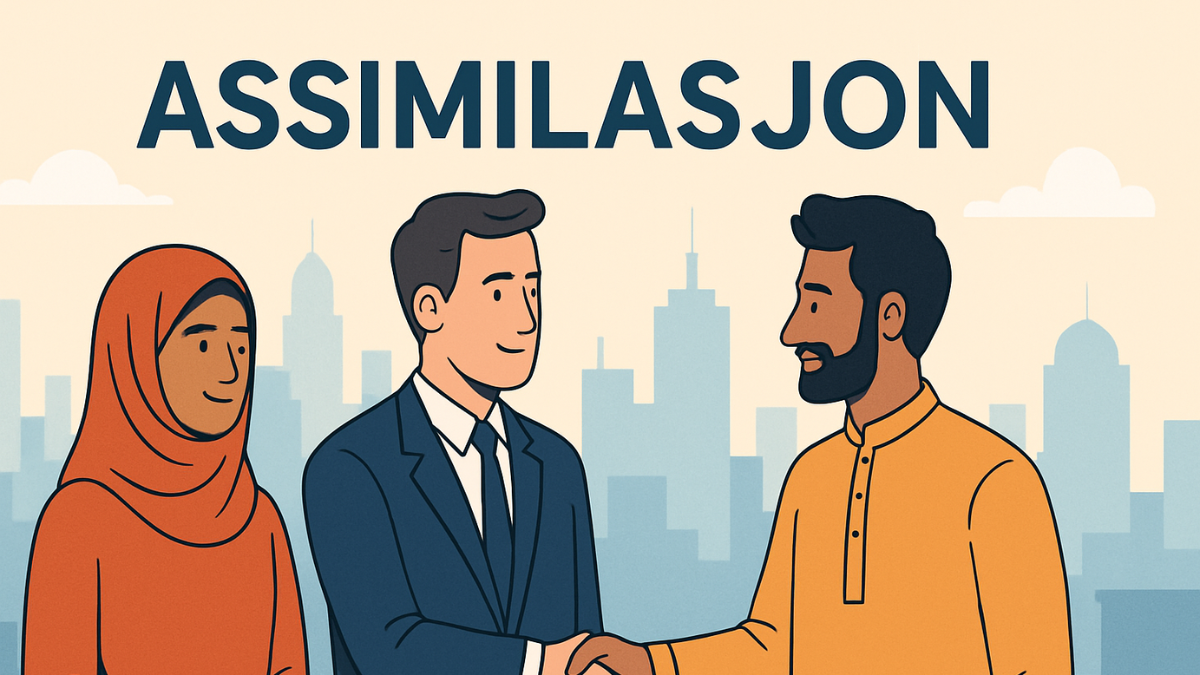Explore the concept of assimilasjon, its cultural significance, historical background, and effects on immigrants and society. Learn about integration, identity loss, and modern challenges.
also read: https://usaenliinea.com/bencodesesports-com-a-full-guide-to-the-esports-revolution/
What Is Assimilasjon?
Assimilasjon is a term derived from the Latin word “assimilare,” which means “to make similar.” In modern usage, especially in sociology and cultural studies, assimilasjon refers to the process by which individuals or groups adopt the cultural traits, language, norms, and behaviors of another, often dominant, society—gradually becoming indistinguishable from the mainstream population.
The process is frequently observed in the context of immigration, where minority or immigrant communities adapt to the cultural environment of their host country. However, it is also seen in historical colonization, inter-cultural relationships, and socio-political integration policies.
Historical Background of Assimilasjon
The concept of assimilasjon has deep roots in colonial history, nationalism, and state-building. In the 19th and 20th centuries, many European countries enforced policies aimed at homogenizing national identity by encouraging or forcing minorities to assimilate. These efforts often involved the suppression of local languages, indigenous traditions, and unique religious practices.
For example:
- Norwegianization policy in Norway aimed at assimilating the Sámi people.
- The French assimilation model expected immigrants to adopt French language and values fully.
- In the United States, Native American children were historically placed in boarding schools to “civilize” them through cultural assimilation.
These examples show that assimilasjon has not always been voluntary and has sometimes involved significant loss of identity and heritage.
Assimilasjon vs. Integration: Understanding the Difference
Though closely related, assimilasjon is not the same as integration. These two concepts differ primarily in the extent to which minority cultures are expected to conform to the dominant culture.
| Concept | Definition | Key Characteristic |
|---|---|---|
| Assimilasjon | Absorption of minority groups into the dominant culture, losing original identity | One-way adaptation |
| Integration | Mutual accommodation where minorities retain cultural identity while adapting | Two-way exchange and coexistence |
Assimilasjon often requires complete abandonment of one’s original cultural identity, while integration encourages cultural diversity within a unified society.
Stages of Assimilasjon
Assimilasjon is not an instant transformation but a gradual process. It generally occurs in the following stages:
1. Cultural Contact
This is the initial phase where two cultures come into contact—usually through migration, colonization, or globalization.
2. Cultural Adaptation
Here, individuals begin to adopt new customs, language, or behaviors to fit into the host society. It can be superficial or deeper depending on necessity or desire.
3. Cultural Acceptance
The new practices become internalized. Individuals start identifying more with the dominant culture than their native one.
4. Identity Transformation
At this stage, individuals or entire communities may lose most of their original cultural traits and fully embrace the new identity.
Factors Influencing Assimilasjon
Several social, political, and personal factors influence how assimilation unfolds:
Language Acquisition
Learning the dominant language is a major step in assimilation. Language often serves as a gateway to cultural understanding and social acceptance.
Education System
Schooling plays a significant role, especially for second-generation immigrants. Curriculums often reflect national values and norms that encourage assimilation.
Employment and Economic Pressure
To survive economically, immigrants may be required to conform to workplace norms, including language, behavior, and dress codes.
Legal and Immigration Policies
Government regulations can either promote multiculturalism or encourage assimilasjon. Some countries support cultural retention, while others push for full assimilation.
Positive Aspects of Assimilasjon
While assimilasjon is often criticized, it can also offer benefits under the right conditions:
- Social Cohesion: Assimilation can reduce social conflict by creating a shared identity or sense of belonging.
- Economic Mobility: Adapting to the dominant culture may open doors to better job opportunities and integration into mainstream markets.
- National Unity: A common cultural framework can promote patriotism and national loyalty.
Challenges and Criticism of Assimilasjon
Assimilasjon becomes problematic when it leads to cultural erasure or forced conformity. Some of the major criticisms include:
Loss of Cultural Identity
Individuals often lose language, customs, and traditions that are deeply tied to their sense of self.
Psychological Impact
The pressure to assimilate can lead to stress, identity crisis, or alienation—especially when individuals feel they don’t fully belong to either culture.
Discrimination and Racism
Even when individuals fully assimilate, they might still face discrimination based on ethnicity, religion, or appearance, proving that assimilation doesn’t always guarantee acceptance.
Modern Debates Around Assimilasjon
In today’s globalized world, the debate between assimilation and multiculturalism continues. Some argue that assimilation is essential for national security, unity, and efficient governance. Others counter that forcing people to give up their heritage for acceptance is a violation of human rights.
Countries like Canada and Sweden are praised for encouraging multicultural integration, while others like France emphasize secularism and cultural unity—leaning more towards assimilasjon.
Case Study: Assimilasjon of Second-Generation Immigrants
Second-generation immigrants (children born to immigrants in the host country) often face complex identity challenges. They may speak the dominant language fluently, attend local schools, and adopt cultural norms, yet still feel disconnected from both their parents’ culture and the society they were raised in.
This dual identity can be both enriching and confusing. Assimilasjon may seem like a path to acceptance, but often, cultural roots resurface in the form of hybrid identities, like “Pakistani-Norwegian” or “Turkish-German.”
How to Balance Assimilasjon and Cultural Preservation
The ideal approach may not be full assimilation, but a balanced, inclusive model that allows for both adaptation and cultural preservation. Governments, educators, and community leaders play an important role in making this possible by:
- Encouraging bilingual education.
- Celebrating cultural festivals.
- Supporting ethnic community centers.
- Providing cultural sensitivity training in schools and workplaces.
These practices ensure people feel accepted without being forced to abandon who they are.
FAQs About Assimilasjon
1. Is assimilasjon always a voluntary process?
No, sometimes it occurs through pressure, laws, or societal expectations, making it involuntary.
2. Can someone be partially assimilated?
Yes, individuals may adopt certain cultural aspects while retaining parts of their original identity.
3. Does assimilasjon happen in multicultural societies?
Yes, even in diverse societies, dominant cultural norms may still pressure minorities to assimilate.
4. What is linguistic assimilation?
It refers to adopting the dominant language, often at the expense of one’s native tongue.
5. How does the internet affect assimilasjon?
Digital platforms can both promote assimilation (through global trends) and resist it (by preserving culture).
6. Are there any legal protections against forced assimilation?
Some international laws, like those by the UN, protect minority rights and cultural heritage.
7. Can culture be fully erased through assimilasjon?
While outward practices may fade, cultural memory often survives in stories, rituals, and family traditions.
8. Does assimilasjon affect mental health?
Yes, especially when identity conflict or societal rejection occurs during the process.
9. How does religion play a role in assimilasjon?
Religious beliefs may either facilitate or resist assimilation depending on compatibility with the host culture.
10. Can food habits show signs of assimilasjon?
Absolutely. Diet changes, adoption of local cuisines, or abandonment of traditional foods often reflect assimilation levels.
Conclusion: A Nuanced Perspective on Assimilasjon
Assimilasjon is a complex and layered process that has evolved over time. While it can foster unity, open opportunities, and help individuals integrate into society, it also carries the risk of cultural loss and psychological challenges. The key lies in balancing adaptation with identity preservation, creating a society where people can feel both included and true to their roots.
In an increasingly interconnected world, understanding assimilasjon helps us shape inclusive societies that respect diversity while encouraging participation. Whether through education, community support, or policy reform, fostering respectful cultural exchange is far more sustainable than demanding complete assimilation.
also read: https://usaenliinea.com/bollyflix-a-complete-guide-to-the-popular-streaming-and-download-platform/
also read: https://usaenliinea.com/striped-shirt-the-complete-guide-to-timeless-style/
also read: https://usaenliinea.com/set-squares/
also read: https://usaenliinea.com/understanding-contra-entry-in-accounting-meaning-examples-and-importance/
also read: https://usaenliinea.com/zuyomernon-system-basketball-the-future-of-strategic-game-play/
also read: https://usaenliinea.com/faibloh/
also read: https://usaenliinea.com/skip-the-germs-a-comprehensive-guide-to-healthier-living/







